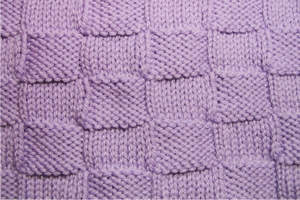Below are photos of my foray into topological textiles over the last few weeks.
For those of yall just tuning in, topology is the study of curved surfaces.
1. My first attempt at knittnig a Klein bottle, which is a surface
with only one side. In textiles (knitting, crochet, weaving), this means that the two sides of the resulting fabric are continuous.
If that didn't make sense, let's take a step back into two dimensions.
Consider a Mobius strip (pardon the missing umlaut).

You've probably made one in school by twisting a strip of paper. The original paper had two sides and two
pairs of parallel edges; the resulting Mobius strip has
one side, because now the two sides are continuous, and only one edge.
To make a Klein bottle, you start with a very stretchy cylinder, turn one end inside out and then connect the two ends. This can only truly be done in four dimensions. In three dimensions, we can approximate it with a surface that has a self-intersection (where the surface passes through itself).
Nifty diagram here:
http://inperc.com/wiki/index.php?title=Klein_bottle
And like the Mobius strip, this surface now has only one side! Not just that, but it's a
closed surface (like a sphere), yet the interior is continuous with the exterior! Think of a beach ball (sphere). If you're on the inside, you can't get out, and vice versa. A Klein bottle is also a closed surface, but if you're inside, you can get out through the neck-like part. All thanks to the self-intersection, which, again, is how we cheat in three dimensions.
It's hard to get your head around unless you have a physical model you can touch and turn around and around (because it's non-orientable) and stick your fingers into. This is where knitting comes in!
Here's the knitted Klein bottle from above, er, from the side with the opening.
Knitters will notice that I cheated by switching from stockinette to reverse stockinette at the point where the work turns inside out. That's one the problems with knitting; it doesn't always look the same on both sides, and a Klein bottle should, because the two sides connect.
My first Klein sock. Most socks have an inside and and outside; this one, of course, has only one side. I started with a sock pattern, left a hole in the top of the foot, made the toe extra long and narrow, drew it through the hole (had to cut the yarn and reconnect it), widened it to the width of the cuff, and connected the two ends.
On to crochet! Not only is crochet naturally reversible (looks the same on both sides), but it's sturdier and holds its shape better. Pictured here is a Klein change purse from the... top? You could call any side the top.
From the side (relative to the the top I defined).
The opening (in the bottom) where the money goes in.
The coins go in through the opening, through the neck, and fall back to the bottom. You have to rotate the shake the purse and kind of manipulate the coins through. The upside is it would really confuse a thief, and it makes you think twice about spending your money!
Next up:
The sleeve and shoulder of a life-sized shrug modeled on the tiny one I posted about earlier.
It looked fine from the front, but the back was all bunched up because the curvature of the two circular pieces was greater than the curvature of my back. Turns out my super-easy shrug pattern was too good to be true. Knitting and crocheting clothes would be a lot easier if the human body were more mathematical.
Finally, the beginning of my pink torus, which I'm planning to embroider the
Tonnetz on.
Again, the project had a surprise in store: as you can see, the torus is beginning to twist into a hollow corkscrew shape. Which is kind of cool mathematically - it's like the equivalent of a computer error message - but it's not what I had in mind.
I'm pretty sure this is due to the nature of chrochet: it's not a series of rings stacked on top of each other, but each successive row is shifted over half a stitch, because you make a stictch between two stitches in the previous row.
I'm hoping to work around this by making several shorter segments and sewing them together into a torus. If my calculations are correct (okay, more like a nonmathematical hunch), the curvature of two mirror-image segments should cancel each other out, giving me a nice symmetrical, non-squiggly torus. Here goes!
























+system+IV+D.jpg)


